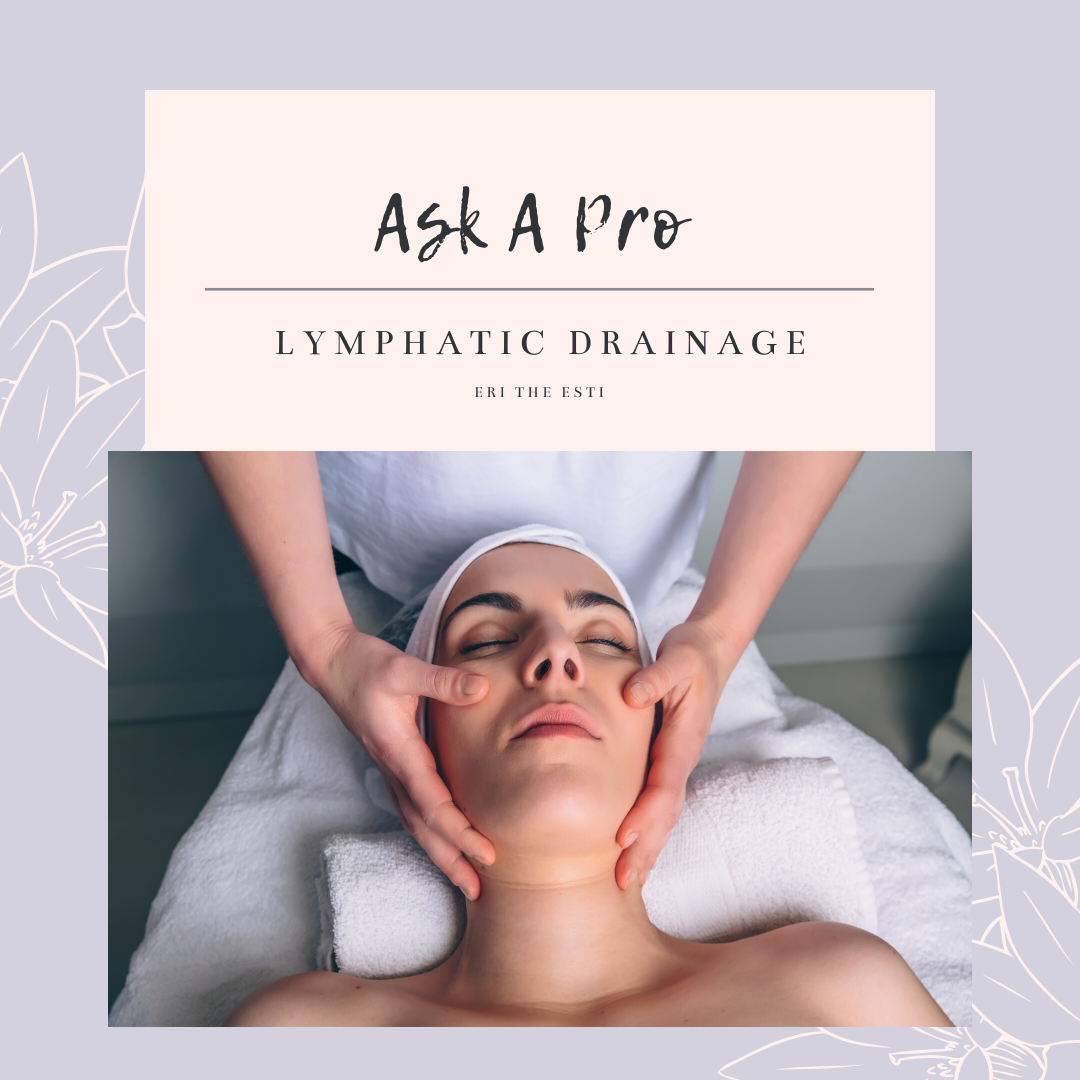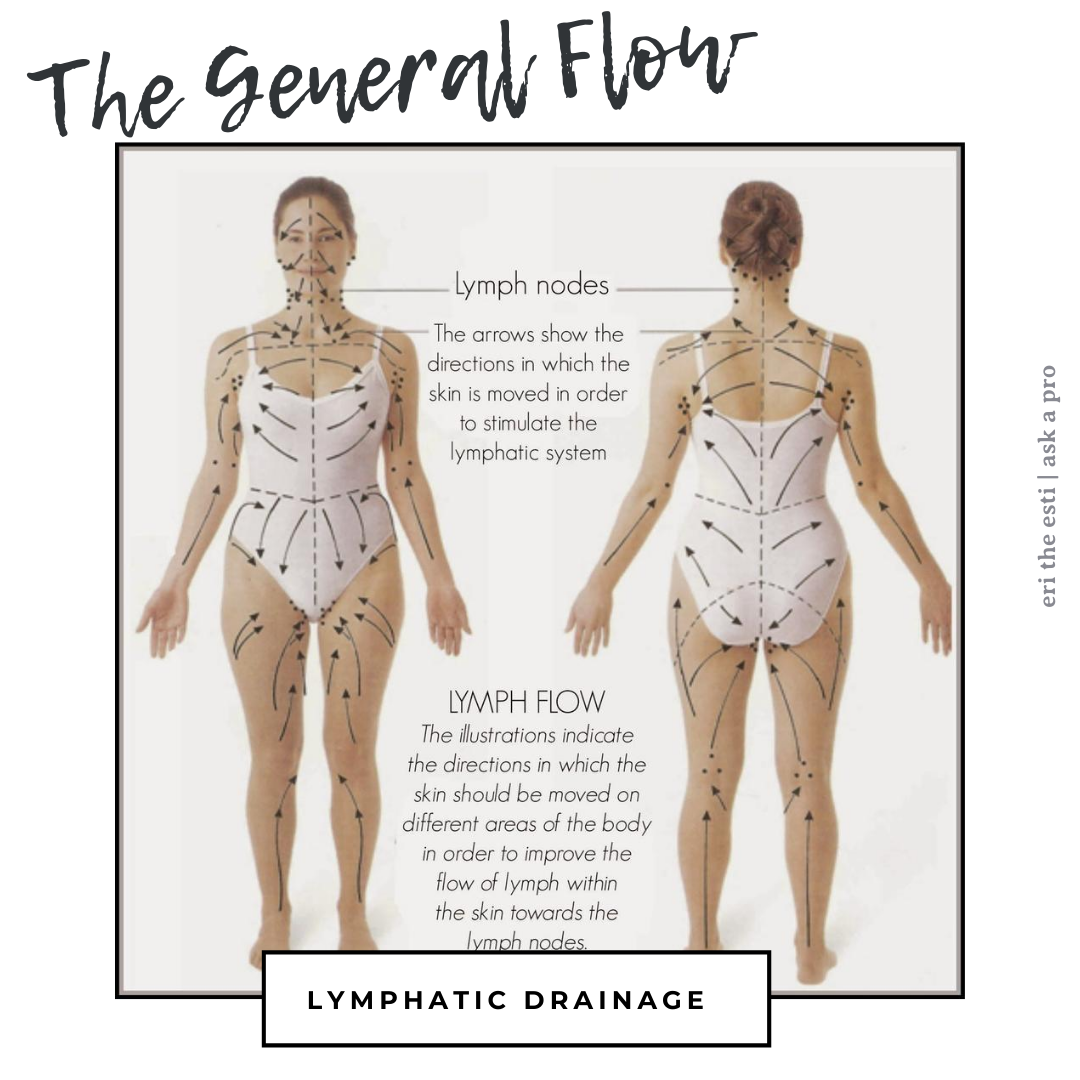Ask A Pro: The Basics on Lymphatic Drainage
Lymphatic drainage, for those who haven’t experienced this type of massage, is amazing. I always feel so clear, de-puffed, and my skin appears brighter afterwards. My clients love when I perform this modality during their facial massage, and recently theres been a lot more attention to the tools that support lymphatic drainage, like the jade roller and dry brushing.
But before I get carried away, let’s break down what exactly is lymphatic drainage and the lymph system.
“The lymphatic system is a network of tissues and organs that help rid the body of toxins, waste and other unwanted materials. The primary function of the lymphatic system is to transport lymph, a fluid containing infection-fighting white blood cells, throughout the body. ”
Your lymph system definitely has a role to play in the immune department. As noted above, it carries waste and debris out of your body. I don’t know if your mom ever did this, but hands down any time I said I felt sick, my mom put her fingertips at the junction of my throat and jaw and “checked my lymph nodes”.
If they felt swollen to her, she was convinced I was telling the truth. If they didn’t, she would tell me to wait it out, drink lots of fluids, and maybe sweat it out if I had any real symptoms. I still apply this logic to myself today, and it hasn’t let me down so far, but I am not a medical professional nor is my mother so please don’t take our word for it!
In short, the lymph system does play a role in your bodies ability to fight off infection and dis-ease to some degree. When it comes to the modality we use in our massage, at least for facials, it has a few other perks.
Lymphatic drainage is a type of massage technique both for the body and for the face that uses very light pressure to “assist in moving” lymph through the lymph vessels and capillaries to your lymph nodes. It feels great to do when you are feeling congested or suffering from sinus pain, the technique is light but effective. It is important to note that lymphatic drainage massage, or manual lymph drainage, is not a remedy for ailments, but more like a supplement is to a healthy diet. It supports circulation, which is so beneficial for your body, but won’t cure you and you still need to maintain a healthy lifestyle and daily self care routine.
“Lymphatic massage, also called lymphatic drainage or manual lymph drainage, is a technique developed in Germany for treatment of lymphedema, an accumulation of fluid that can occur after lymph nodes are removed during surgery, most often a mastectomy for breast cancer...
As long as long as your lymphatic tissues or lymph nodes have not been damaged or removed, Dr. Weil maintains that that there is no need to worry about lymphatic flow and drainage.”
Regardless of the need or benefits from lymphatic drainage, one thing is true, it feels like it is doing something good for you, and that’s enough for me! There are so many different ways to perform lymphatic draining, just look it up on YouTube and you’ll find other practitioners and just regular old folks going on about how amazing this modality is.
In researching for this blog I fell down a rabbit hole of watching all these YouTube videos on different ways to practice facial lymphatic drainage, which then resulted in me standing in front of my bathroom mirror practicing alongside the videos. It felt amazing! It also showed me just how many tools I own who function to support our bodies lymphatic drainage and circulation, the jade/quartz/rose quartz roller, gua sha facial stones, dry brushes just to name a few. Even though there’s a lot of tools to try, the technique is relatively the same.
There are a lot of videos on how to do this, so I am not going to give you specific moves but more general like how to apply pressure, what part of your hand you are using, and the direction of drainage. You can apply this to all the tools you might use in your process, except dry brushing as it is not meant for the face. Let’s begin.
General Lymphatic Drainage Techniques:
*Before you begin, make sure your skin is clean and has some kind of oil on it to aid with slip and glide. I recommend professional facial oils like Alana Mitchell’s CBD Facial Rejuvenating Oil, its really hydrating without staying “greasy” in feel. I wouldn’t use an oil that has any exfoliating properties like retinol for massage techniques. If you feel like your skin is oily enough and don’t want to use a facial oil, try Skin Script’s Ageless Hydration Serum and get major skin hydrating benefits too!
*All lymphatic drainage techniques can be repeated 3, 6, or 9 times. For sake of this brief explanation, I will reference 3 times for each move.
With flat palms, begin behind your ear with very light pressure, never dragging the skin, down towards your clavicle. Repeat 3x on each side, can do individually or together
Make a fist with your thumb on the outside, fit your jawline starting from the center of your chin in between the groove of your thrum and index finger. With light pressure, not dragging the skin, draw your fingers towards your ear and base of the jawline. Repeat 3x
Keeping hands in fits shape, using the backside of thumbs from the nasal-labial fold to side of the ear, drain 3x
Make a “v” shape with index and middle finger, place index fingertips at beginning of brow and nose bridge, and middle fingertips at the end of your eyebrow. Press down gently for the count of 3 seconds and release, repeat 3x
With flat hands, press fingers to temples and drain down side of face, back down behind your ears, down your neck and back to your clavicle, repeat 3x
Having hands in prayer position in the center of the forehead, draw sides of hands towards temples, repeat 3x
Place index finger (can add ring finger) to where brow and nose bridge meet, begin going down the side of the nose, under and around eyes circling with light pressure 3x always stopping at temples for extra press
Finish with flat hands palms on the forehead, sweep hands down the side of face, pressing lightly at temples, gliding back down around the ears, side of your neck, and back to the clavicle pressing down gently on your shoulders. Repeat 3x
Below is an example of full-body lymphatic drainage. The important thing to note, whichever tool you might add in or even just with hand pressure, is to go the correct direction and with light pressure, never dragging the skin:
Once you have an idea of the direction, speed and pressure at which you are massaging, you’re ready to add in tools of the trade.
A few years ago, the jade roller was like the hot topic in the skin care community. It was everywhere! When I went to a trade show, most booths had some kind of jade or quartz tool to sell. Luckily, being an avid shopper, I already had a jade roller at work, and a rose quartz roller at home.
So what’s the difference between the two? Other then the properties of the stones themselves, jade is naturally cool for example, they aren’t much different and do pretty much the same thing. I tend to have more pink in my skin and now prefer the jade roller. Yes, this means I now have both, a jade and quartz roller at home, but I just alternate use.
In the same family is this other little gem that popped up on the scene, Gua Sha, a jade “carving” stone with little notches and grooves. Now, at first when I saw it, I immediately flashed back to 2013 when I worked at Origins and they rolled out this really cool jade facial tool for us to use in our on-site facial treatments. I didn’t know much about it, and no one I worked with was really into using it, but I did get to experience a facial with it and I loved it. So what the heck is it?
“Gua sha is a natural, alternative therapy that involves scraping your skin with a massage tool to improve your circulation. This ancient Chinese healing technique may offer a unique approach to better health, addressing issues like chronic pain.”
Naturally, I had to invest in an at home Gua Sha set to be able to have firsthand experiences for my clients, aka I wanted one.
Again, the moves, the light pressure and the direction are similar, just always make sure you are going slow with your movements. Another tip to keep in mind, when apply the Gua Sha stone to your skin it’s not going to be perpendicular to your skin, but almost flat against it. The idea is to aid in the movement of lymph and increase circulation, not deep tissue facial massage.
I am not an expert on Gua Sha and won’t claim to know the best ways to use it, but it is awesome and something I will continue to learn more about. Another tool you might find in the mix is dry brushing.
I feel like I talk about dry brushing all the time, but when I went to go back and find an article on it, I couldn’t find one, so let me go a little into it here. In an article written by Jamie Starkey, LAC, about lymphatic drainage, they say:
The mechanical action of dry brushing is wonderful for exfoliating dry winter skin. It also helps detoxify by increasing blood circulation and promoting lymph flow/drainage. Dry brushing unclogs pores in the exfoliation process. It also stimulates your nervous system, which can make you feel invigorated afterward.
https://health.clevelandclinic.org/the-truth-about-dry-brushing-and-what-it-does-for-you/
Exfoliating your skin is always good, as long as its never harsh nor aggressive. Helping your skin slough off the dead stuff will support so much more than just the surface of your skin.
Key Steps to Dry Brushing
Typically you want to dry brush your skin before or after a shower, this will help minimize the dust you’re adding to the room
If after a shower, go over skin lightly with a clean towel to dust off any excess dead skin
Always brush in an upward sweeping direction towards your heart
Use light pressure, the bristle are tough enough they don’t need help!
Follow with hydrating body moisturizer and possibly a body oil
Try this once a week at first, no more than three times a week
That was a lot of information! Keep your eyes peeled for my upcoming “Back to Basics 2.0 Tools” series that will be going into depth on popular beauty tools.
Till next time, be good to your skin and even better to yourself,
xx eri






